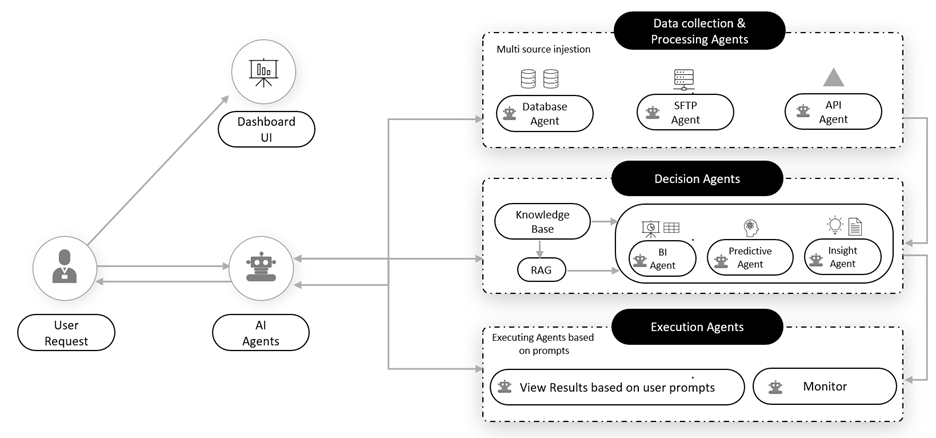
Agentic AI: Ushering in a new age of business intelligence
Sachin Garg, Executive Vice President, Consulting and Analytics
How is artificial intelligence reshaping business intelligence?
Artificial intelligence has ushered business intelligence (BI) into a new phase, one defined by speed, adaptability, and smarter decision-making. Rather than replacing traditional BI, it’s expanding its scope and impact, paving the way for Agentic AI to enable deeper, autonomous insights across the enterprise.
There has been a shift in the Business Intelligence (BI) landscape – BI driven by artificial intelligence is the new normal that the world has experienced. However, with the recent technological proliferation and the advent of agentic AI, BI is undergoing an accelerating transformational shift. Although AI has impressed many with its capabilities, it is agentic AI that is truly revolutionizing BI in its truest sense.
Simply put, the term “agentic” in agentic AI highlights its agentic properties – that is, characteristics akin to those of an agent, particularly regarding autonomy and the capacity to perform independent actions with minimal human intervention. Organizations, industry leaders, and others alike agree that the upheaval in BI has somewhat unraveled the usual practices, providing a new steer, and transforming traditional workflows. So, what has changed?
Unlike traditional business intelligence solutions, which rely on manual processes, agentic AI continuously monitors data, autonomously detects patterns, and recommends or initiates real-time actions, all while continuing to learn from its experiences.
What are the key capabilities of Agentic AI-powered business intelligence?
Agentic AI enhances business intelligence by enabling autonomous analysis, prediction, and decision-making. It empowers organizations to move from static reporting to continuous optimization, using real-time insights and adaptive systems that improve accuracy, agility, and efficiency across functions.
Key capabilities include:
- Autonomous KPI Monitoring: Tracks KPIs, detects anomalies, and applies corrective measures instantly, reducing dependence on manual intervention.
- Predictive and Prescriptive Analytics: Goes beyond forecasting, advising and executing strategic actions based on predictive insights.
- Financial Planning: Provides dynamic, real-time financial analyses and scenario-based simulations, replacing static reports.
- Customer Experience: Personalizes engagement strategies, adapting offers and responses in real time.
Why is 2026 the year of Agentic AI?
2026 marks the tipping point where Agentic AI moves from experimentation to large-scale enterprise adoption. Organizations are now leveraging autonomous agents to make decisions, adapt dynamically, and execute tasks, transforming AI from an analytical tool into an active business partner.
As agentic AI expands its groundbreaking capabilities, it unlocks strategic advantages for enterprises, starting with autonomous decision-making, dynamic adaptation, and efficient automation. Leveraging its perception, cognitive, and action modules, the interconnected architecture facilitates intelligent behavior.


What are the advantages of Agentic AI?
Agentic AI extends the capabilities of traditional models by combining autonomy, context awareness and action, allowing systems to not only analyze data, but to take validated decisions and execute tasks. Agentic AI’s early adopters are poised to gain a significant competitive edge, reaping substantial benefits, including:
● Proactive: Agents anticipate issues and surface actionable recommendations, moving organizations from reactive reporting to forward-looking operations.
● Enhanced: Agentic AI automates repetitive workflows and data processing, reducing manual effort and improving overall speed and consistency.
● More precise and scalable data-driven decisions: Continuous learning enables faster, more accurate decisions that scale insights across the organization.
● Significant financial gains through improved productivity and optimization: Self-learning automation cuts inefficiencies and drives measurable ROI.
● Access to data through AI-driven analytics: Agentic AI unifies data sources, turning real-time information into actionable insights.
● Transparent and governed: Each agent’s decisions are explainable and traceable, ensuring responsible AI use and alignment with enterprise governance standards.
● Seamless integration: Agentic AI connects with existing systems and APIs, extending automation without disrupting legacy processes.
Agentic analytics: Transforming analytics with AI-driven intelligence
Business Intelligence has been historically viewed as a reactive tool, depending on the user to manually extract and interpret data from reports and dashboards – agentic AI is changing just that. It is ushering in a paradigm shift that’ll allow autonomous AI agents to engage with data and handle end-to-end tasks ranging from data preparation to model building, transforming static dashboards to intelligent, autonomous business insights.
Agentic AI is capable of transforming the entire data journey, right from automating insight discovery, anticipating business needs, and initiating and executing recommendations in real-time, while also taking the offerings a notch higher with self-service analytics, user-friendly visualizations, and accelerated decision-making support.
|
|
|
|
|
|
How can organizations implement Agentic AI effectively?
To implement Agentic AI successfully, enterprises must focus on strong data foundations, clear governance, and scalable pilot programs. These steps ensure that AI agents operate responsibly, integrate seamlessly with existing BI systems, and deliver measurable business outcomes.
Key steps for implementing agentic AI:
- Strong Data Foundation: Unify data sources, ensure accuracy, and maintain consistency through governance
- Select AI Architecture: Use built-in BI tools or integrate custom LLMs with real-time pipelines
- AI Governance: Ensure transparency, set approval thresholds, and monitor AI decisions
- Pilot and Scale: Begin with impactful use cases, validate results, and expand strategically
Agentic AI is emerging as an essential part of BI, which will eventually influence how enterprises make data-driven decisions in the future. As major leaders gear up to embed AI agents into their broader BI ecosystems, accelerating the shift toward autonomous business intelligence, it also highlights critical challenges revolving around data governance and security.
While the benefits of AI, including Agentic AI in business intelligence, are vast and offer competitive advantage and growth potential, its impact goes beyond analytics and is transforming how organizations operate, make decisions and create value. From AI-powered customer experience and automated translation to accent softening and AI data services, AI and agentic systems are reshaping how enterprises operate and interact with customers globally.
On the other hand, late adopters risk falling behind, grappling with inefficiencies, and missing out on significant revenue potential.
Interested in learning more? Read our exclusive new paper, Scaling Live Support with AI. It’s the latest in our ongoing collaboration with MIT Technology Review Insights to remain at the forefront of technology and innovation.
